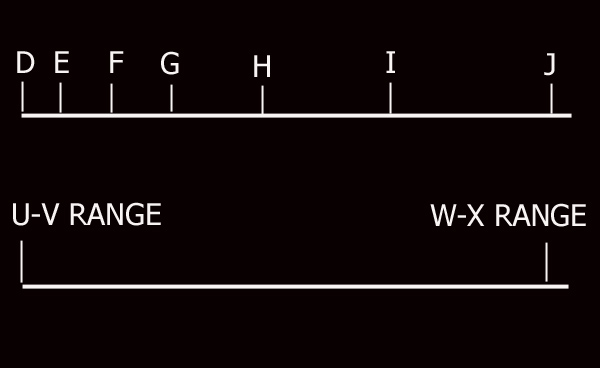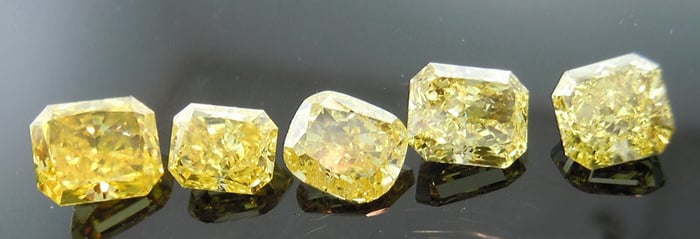How Are Diamonds Made? Natural vs Lab-Created Explained
Two Paths, One Diamond Not all diamonds come from the same place — but they all start the same way. Pure carbon, crystalized under immense pressure and heat. Whether it…
Fancy Vivid Yellow – “The King of Yellow Diamonds.” This article will delve into the world of these most highly prized yellow diamonds.

Fancy Vivid Yellow diamond
At one end of the lettered color scale, which many readers know starts at D, is a totally colorless diamond. The lighter yellow shades, U-V, W-X and Y-Z are at the other end of the scale. If a diamond has more yellow than Y-Z range, the next darker shade is called Fancy Light Yellow. The scale progresses to the deeper yellows, Fancy Yellow, then Fancy Intense Yellow, and finally Fancy Vivid Yellow, which is the subject of this article.
There are two grades, which are darker or deeper yellow, Fancy Dark Yellow and Fancy Deep Yellow. Fancy Deep and Fancy Dark Yellow stones are generally less prized than Fancy Vivid Yellow, although this is not always the case.


Diamond color scale, as it applies to yellow from both the face-up and profile viewing angles.
This guide will discuss the potential variances possible within the grade of Fancy Vivid Yellow. Remember that each GIA designated color is actually a range. Some D color diamonds are actually whiter than other diamonds graded D color from GIA. As we go down the scale of color, the range of each color grade gets wider. To use a graphic analogy, if the space between D and E color is 1 inch, the space between I and J color is about 5 inches. Once we get down to the fancy yellow grades, this becomes even wider. Using the same analogy, GIA’s Fancy Vivid Yellow color grade is about 2 feet wide. And, even more variation within the grade is possible. The reason is that undertones of the color that are not classified as modifying colors can come into play.

This chart represents the size of different color ranges. The width of “Fancy Vivid Yellow” is twice again as wide as the figurative distance between U-V and W-X range.
When considering the task at hand given to GIA regarding color grading of fancy colored diamonds, it’s important to remember that yellow as a color is far more “complicated” as compared to white. I have mentioned a variation within D color diamonds. Such variation is incredibly subtle. As we can see in the photos below, the variation within diamonds graded Fancy Vivid Yellow can be quite dramatic.


All five diamonds were graded Fancy Vivid Yellow by GIA.
In the photos above, the stone on the far left exhibited remarkable color. The stone, which had a clarity grade of SI2, traded at about 50% more than a comparable stone possessing color similar to one of the stones on the far right.
Regarding the two stones on the far right, they are at the lightest end of GIA’s Fancy Vivid Yellow color grade. In my experience, borderline stones exist that can get Fancy Intense Yellow on one day and Fancy Vivid Yellow the next. The two stones on the right are such borderline stones. They are darker than about 95% of the GIA graded Fancy Intense Yellow diamonds you will see. However the top few percent of the deepest yellow diamonds graded Fancy Intense Yellow by GIA may indeed have more color than the two diamonds on the right. The reasons have to do with the complexity of the color and the fact that grading is done by human eyes. Color grading of natural yellow diamonds is simply not an “exact science.”

Although the photo above shows a clear difference from Fancy Intense Yellow to Fancy Vivid Yellow, at the fringe of these two grades, stones can sometimes go either way.
The deepest colored diamond graded Fancy Vivid Yellow is not necessarily the most desirable. Once we reach the level of Vivid Yellow, the color is so deep that there may be many complexities within the grade, as GIA defines it.
Some extremely deeply colored vivid yellows seem to have a less than desirable orange to them. Pure Orange is an extremely sought after and rare color in diamonds, but orange is not desirable to most buyers of a Fancy Vivid Yellow. As we can see in the photo of a GIA graded Fancy Vivid Orange Yellow below, the combination of orange and yellow certainly hints of brown.

Even a hint of brown can have a huge negative effect on the market value of a Fancy Vivid Yellow. There are many stones with these subtle undertones that are not classified as secondary colors which still receive the Fancy Vivid Yellow grade from GIA.
If the secondary color is strong enough, GIA will add that modifier to the color. This is a subject that deserves and article in its own right, but as it pertains to Vivid, the secondary colors are Fancy Vivid Green(ish) Yellow and Fancy Vivid Orange(y) Yellow (shown above). I do not believe GIA issues a Fancy Vivid Brownish Yellow grade. Here’s an example of a Fancy Vivid Green Yellow diamond with a green modifier noted on the GIA report.


Photo on the left taken in a light box with little UV – Photo on right under UV penlight
The stone above was graded Fancy Vivid Green-Yellow by GIA with Strong Green fluorescence. In my opinion, it gave the stone a rather dull appearance, and the color did not reflect the GIA grade under normal room lighting. As you can see in the UV photo, the diamond did have a lot of green to it. Normally, green is a very valuable color in diamonds. But this particular Fancy Vivid Green–Yellow is a great example of how purity of color plays a huge role in price and desirability. It was not a costly diamond, especially considering the grade. It’s conceivable that another Fancy Vivid Green Yellow might be extremely desirable and costly.
Since color is such an important element in the desirability and market value of a Fancy Vivid Yellow, purity and depth of color have a huge impact on the price of a given Vivid Yellow Diamond.
There are still other factors to take into account. These factors include fluorescence, quality of cut, type of cut, and of course, clarity.
In my experience, between 20-30% of Vivid Yellow Diamonds glow when exposed to UV lighting. This is known as fluorescence. The most common color for fluorescence is blue. However, we have also seen diamonds with yellow fluorescence, green fluorescence, orange fluorescence, and white fluorescence. Fluorescence plays a huge role in perceived color and value. In general, fluorescence devalues a vivid yellow.
Strong blue fluorescence may interfere with the transmission of color, or the purity of the color in a number of ways.
A small percentage of Medium or Strong fluorescent diamonds take on a “sleepy” (hazy and dull) appearance. This occurs in a small percentage of both colorless and Vivid Yellow.
Another possibility is one where the interaction between blue fluorescence, and the strong yellow of a vivid diamond, creates a situation where the diamond is not sleepy, or hazy, but it impacts the color in a negative sense, even in non-ultraviolet rich situations. Such stones are seen as highly undesirable on the market, with a large impact on price and value.
Yet, fluorescence in Vivid Yellows is not always a negative. The presence of Medium or Strong Blue can actually increase perceived yellow color in non UV rich indoor lighting. Some of the strongest colored stones possess fluorescence.
Fluorescence really does take on many different forms. Fluorescent Fancy Vivid Yellow diamonds are most commonly seen with blue fluorescence, but in these really deep colors, yellow fluorescence is also prevalent. Bottom line here: Fluorescence is a wildcard in a Vivid Yellow as far as appearance. It can hurt, do nothing, or actually help the color.

Shown above and below, this 2-carat diamond graded Fancy Vivid Yellow exhibited Medium Blue Fluorescence as indicated on the GIA report.

The prime goal of a cutter polishing a piece of rough that may yield the color of Fancy Vivid Yellow is to achieve that grade. But he or she has to do so while maintaining yield, and producing a desirable diamond all at the same time. This is a complicated task, but the cutter’s task is made simpler if they choose a cut that has the best optical properties to bring out the yellow. For this and other reasons Fancy Vivid Yellow is rarely seen in round or step cuts such as emerald cuts or asschers.
Cutters generally choose radiant or cushion shapes. Both of these shapes allow the cutter a lot of freedom to change the placement, size, shape, and angle of the facets to suit the goals. Since most of the Vivid Yellows on the market are either radiant or cushion, other fancy shapes may command higher prices. Nice examples of asscher and emerald cuts may bring as much as 50% more than a comparable radiant or cushion. A nicely cut pear shape will bring 5-15% premium over radiant or cushion. Older cuts are incredibly rare in GIA graded Fancy Vivid Yellow. I’m sure they exist, but I can’t recall seeing an Old Mine Brilliant Vivid Yellow.
Given the “mission” of a Fancy Vivid Yellow diamond, clarity, per se, is far less important than in colorless diamonds. That is to say, as long as the stone is eye clean, if it’s got standout color, an SI2 is going to command a higher price than a VVS1 with lesser color. In many cases, the extreme body color can hide imperfections that might be visible in a colorless diamond.
An exception is Fancy Vivid Yellow Internally Flawless (IF). Imagine this grade as the 180 degree opposite of D/Internally Flawless, except the prices can soar even higher for Vivid Yellow Internally Flawless Diamonds. Even Fancy Vivid Yellow (IF) diamonds of “pure, yet weaker” color command high prices. If there’s a purity or fluorescence problem, even an IF will have a diminished value.
COLOR: Barring obvious clarity, cut, or brilliance issues, color trumps all. The most sought after Fancy Vivid Yellow diamond is a stone that is deeply saturated, yet both brilliant and bright at the same time. In the most desirable stones, the yellow is devoid of any secondary colors.
CLARITY: If the color is truly remarkable, many other deficiencies may be overlooked. For example, maybe an SI2 or even I1, might be very desirable to buyers normally used to VS+ (very clean) diamonds.
CUT: Consider the cut from a visual standpoint: Does it show a bright appearance in a shape that pleases you? Does it look its size? Rarity of certain shapes needs to be taken into account when making a “wish list.”
Fluorescence is not easily categorized, although in general it reduces price.
As with all things of such a specialized nature, it’s a good idea for people interested to see as many Fancy Vivid Yellow diamonds as possible to gain a frame of reference. Get a money-back guarantee and research your dealer carefully. We can never stress the following point too frequently: Only consider stones graded by GIA if you want to purchase a true Fancy Vivid Yellow.
by David Friedlander
President
Images © Diamonds by Lauren
Click here to discuss on the Forum